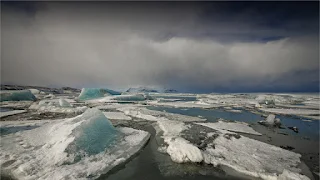-
Scientists have found that the high temperature and high pressure of seawater beneath the "Doomsday Glacier" in West Antarctica is leading to strong melting.
Scientists have found that the high temperature and high pressure of seawater beneath the "Doomsday Glacier" in West Antarctica is leading to strong melting.
A team of glaciologists led by a team from the University of California, Irvine, used high-resolution satellite radar data to detect evidence of warm, high-pressure seawater seeping beneath the glacier.
A statement issued by scientists indicated that the widespread contact between salty and relatively warm ocean waters with the glacier, a process that has been repeated throughout Antarctica and in Greenland, is causing “strong melting,” which may require a re-evaluation of sea level rise expectations. .
The Thwaites Glacier in West Antarctica, nicknamed the "Doomsday Glacier" because its collapse could cause a catastrophic rise in sea levels, is known as the largest glacier in the world and is roughly the size of the state of Florida. It is also one of the most vulnerable and unstable glaciers in Antarctica, largely because the ground it sits on slopes downward, allowing ocean water to eat up its ice.
Thwaites, which already contributes 4% to global sea level rise, contains enough ice to raise sea levels by more than 60 cm. But because it also acts as a natural dam on the surrounding ice in West Antarctica, scientists have estimated that its complete collapse could eventually cause sea levels to rise by about 3 metres, a disaster for the world's coastal communities.
In an attempt to understand the effect of ocean water interaction on the melting of glaciers, glaciologists examined data collected between March 2023 and June 2023, obtained from the Finnish commercial satellite mission ICEYE.
These satellites represent a constellation-like group in polar orbit around the planet. It uses Interferometric Synthetic Aperture Radar (InSAR) to continuously track changes on the Earth's surface.
The data depicted the fluctuations of the Thwaites Glacier. “These ICEYE data provide a long series of daily observations that closely correspond to tidal cycles,” said lead author Eric Renault, professor of Earth system sciences at the University of California, Irvine.
He added: “In the past, we had some intermittent data available, and with only these few observations, it was difficult to know what was happening. When we have a continuous time series and compare that to the tidal cycle, we see seawater coming in at high tide and receding, and in "Sometimes it goes up under the glacier and gets trapped, and thanks to ICEYE, we're starting to see this tidal dynamic for the first time."
Renaut noted that the ICEYE project has helped scientists better understand the behavior of seawater on the lower flanks of the Thwaites Glacier.
He explained that seawater entering the base of the ice sheet, along with fresh water resulting from geothermal heat and friction, accumulates and needs to flow out. This water moves through natural channels or pools in hollows, creating pressure that raises the ice sheet.
“The concern is that we are underestimating the speed at which the glacier is changing, which will be devastating for coastal communities around the world,” said co-author Christine Dow, a professor in the School of Environment at the University of Waterloo in Ontario, Canada. “Right now, we don’t have enough "The information is to somehow tell how much time is left before ocean water leakage becomes irreversible."
She added: “By improving models and focusing our research on these important glaciers, we will try to determine these numbers at least for decades versus centuries. This work will help people adapt to changing ocean levels, along with focusing on reducing carbon emissions to prevent the worst-case scenario.”
The study was published Monday in the journal Proceedings of the National Academy of Sciences.
Tags:
california university
dire effects
doomsday glacier
science
seawater
strong melting
water warming


Informative
ReplyDeleteGlobal warming is on the rise.
ReplyDeleteInformative
ReplyDelete